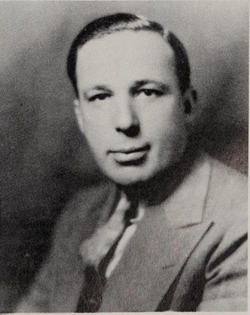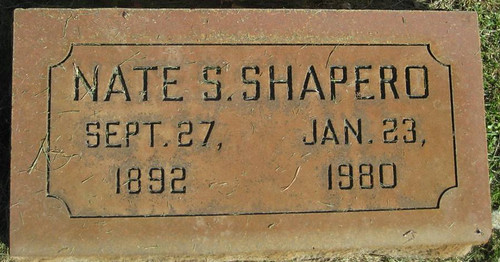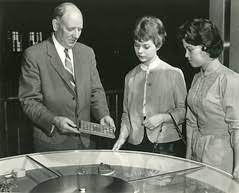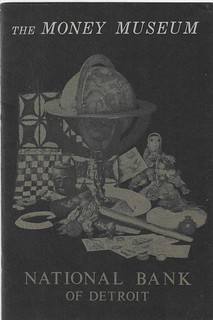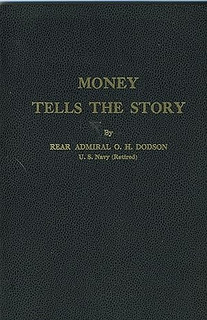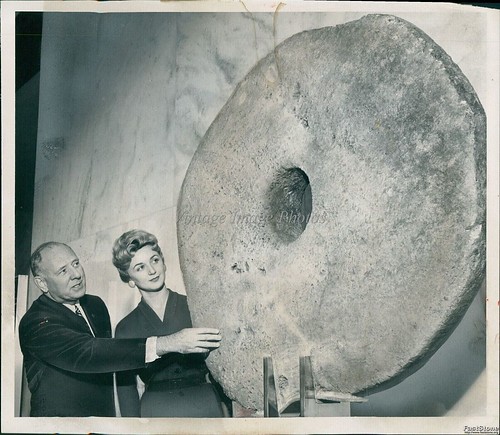
PREV ARTICLE
NEXT ARTICLE
FULL ISSUE
PREV FULL ISSUE
SHAPERO, DODSON AND THEIR MONEY MUSEUMLast week we republished John Regitko's article about the Money Museum of the National Bank of Detroit. E-Sylum Feature Writer and American Numismatic Biographies author Pete Smith submitted this dual article on the museum's founder and first curator. Thanks! -Editor
Nate S. Shapero (1892-1980)
He served in the Navy as a pharmacist mate during the First World War. In 1918, he opened his first drug store as the Economical Drug Company in Detroit. In October 1931, the company was merged with the Cunningham Drug store. Nate was married to Ruth Bernstein (1896-1988) on January 27, 1925, and had two children. He was president of Cunningham Drug Stores with more than a hundred and seventy branches. The company expanded to have its own laundry, to make its own brand of ice cream, and had a photo finishing department. He awarded scholarships for workers to attend Wayne University or the Detroit Institute of Technology. In 1945, he was chairman of the Michigan War Finance Committee. He was a Dollar-A-Year-Man working for the Treasury Department selling bonds and stamps. Shapero gave financial support and leadership to many charitable organizations. He served as president of the Board of Fire Commissioners of Detroit; Past president of Chaim Weizmann Chemical Research Foundation of Rehoboth, Palestine; Board member for Ferris Institute, Big Rapids, Michigan; board member and vice-president of Jewish Welfare Federation of Detroit; board member of National Institute of Distribution, New York; member of Great Lakes Tide-Water Commission; board member of Boy's Club of Detroit; past president of National Association of Chain Drug Stores; executive committee of Detroit Round Table of Christians and Jews; Chairman of National Chain Stores' Section of all U. S. Bond and Stamp campaigns; board member of Temple Beth El.; chairman of Michigan Chain Stores Association; board member of Detroit Community fund; board member of Boy Scouts council; board member of Supervisors of Wayne County; past president of Michigan State Welfare Commission; chairman of the board of Police and Fire Pension Committee; advisory committee member of American Jewish Committee; member of Michigan Crippled Children's Commission; executive committee member of American Retail Federation; member of Allied Industry Committee; and advisory committee member of Fact-Finding Committee for Detroit's World's Fair. On January 17, 1959, Shapiro was in a plane that caught fire shortly after take-off from Miami. There were no fatalities. His business interest and philanthropy got him a position as director of the National Bank of Detroit. Parts of his extensive coin collection, formed over forty years, were donated to the National Bank of Detroit to create their Money Museum. Oscar Dodson was hired to be their first director. In 1964, Wayne State University opened the Shapero Hall of Pharmacy just a dozen blocks from the location of his first store. He endowed the Belle Isle Monkey Theater and the Shapiro School of Practical Nursing at Sinai Hospital. During his lifetime, he made more than $20 million in charitable contributions. He died in a hospital in Palm Beach, Florida, on January 23, 1980. He is buried with Ruth at Clover Hill Park Cemetery in Birmingham, Michigan.
*Commentary
A headstone is not an official document. His headstone gives his name as Nate S. Shapero, his date of birth as Sep. 27, 1892, his date of death as Jan. 23, 1980. Let's assume that is all correct. The FamilySearch site has 19 records linked under the name of Nathaniel Samuel Shapero. Not one of those records gives his name as Nathaniel.
The Detroit Jewish News for September 27, 1957, tells this story: The Find-a-grave site gives his year of death as 1990. I assume this is a clerical error. Biographical sources are subject to errors and should be double-checked and verified.
Oscar Henry Dodson (1905-1996)
He married into a navy family on December 17, 1932. His bride was Pauline Wellbrook, the daughter of commander Howard Wellbrook. She was walked down the aisle by Admiral Thomas J. Senn. The couple left the chapel under the crossed swords of officers attending the wedding. Dodson was communications officer on the USS Hornet during World War II. It was the Hornet that launched planes for the Doolittle raid on Tokyo. The ship was heavily damaged during the Battle of the Santa Cruz Islands, abandoned and sunk. The ship had been in service for just one year and six days. Dodson lost five pounds of coins in his briefcase on the flight deck as the Hornet was abandoned.
On October 26, 1942, The Hornet was attacked by enemy aircraft. An unexploded bomb lodged in a compartment near the communications center. Dodson earned a silver star as noted in the citation, He was commanding officer of the U.S.S. Thomas Jefferson 1949 to 1950. Dodson began collecting coins in Waco, Texas at age 13. He joined the ANA on October 1, 1933, as member 4319. He converted to life membership LM-78 in 1945. While still in the Navy, he served on the Assay Commission in 1948, the ANA Board of Governors during 1950 to 1955 and as vice president 1955 to 1957. Dodson lived for a while in Urbana, Illinois. He received an M.A. in history from the University of Illinois in 1953. During 1950 to 1953, he was a professor of naval science and commander of the Naval Reserve Officers Training Corps at the University of Illinois, He was an assistant professor of history there during 1957 to 1959. Dodson retired from the Navy as Rear Admiral in June of 1957 after thirty years of service. He then served two terms as president of the ANA August 24, 1957 to August 19, 1961. He received the ANA Medal of Merit in 1950 and the ANA Farran Zerbe Memorial Award in 1968. He was also awarded the Numismatic News Numismatic Ambassador Award in 1988. Dodson established the Money Museum at the National Bank of Detroit. He was the museum director from 1959 to 1965. The museum opened on April 28, 1960, the first day of the Central States Numismatic Society convention in Detroit. Much of the material in the museum came from the collection of Nate S. Shapero. While at the museum he released Money Tells the Story in 1962. The Museum was moved to the Renaissance Center in 1977. Dodson left Detroit in 1966 to become director of the Classical and European Culture Museum at the University of Illinois. Charles Hoskins took over as curator of the museum. He created the Mobile Money Museum in a trailer in 1968. It was taken around to local schools. His assistant was Thomas W. Becker. The Mobile Museum tour was discontinued in 1980. The home office museum closed about 1992. Dodson died on January 22, 1996, and is buried at Arlington National Cemetery. In 2000, he was inducted into the American Numismatic Association Hall of Fame.
Question #1
Newspaper articles described the National Bank of Detroit Money Museum as having a rare 1913 Liberty Nickel worth, at the time, $35,000. This is not one of the five known examples. What did they have, and what happened with it?
Question #2
How many money museums have there been in the United States? How many are still open? How many have you visited? [I've been to five] Great articles, and two great questions. Can anyone help? While there have been many numismatic exhibits at conventions and other temporary locations, and exhibits as part of larger museums (such as the National Numismatic Collection at the U.S. Mint and Smithsonian), permanent, separate money museums are less common. I missed out on the National Bank of Detroit Money Museum and the Chase Manhattan Bank Money Museum, but did manage to visit Eric Newman's St. Louis Mercantile Money Museum. -Editor
To read the earlier E-Sylum article, see:
Wayne Homren, Editor The Numismatic Bibliomania Society is a non-profit organization promoting numismatic literature. See our web site at coinbooks.org. To submit items for publication in The E-Sylum, write to the Editor at this address: whomren@gmail.com To subscribe go to: https://my.binhost.com/lists/listinfo/esylum All Rights Reserved. NBS Home Page Contact the NBS webmaster 
|
